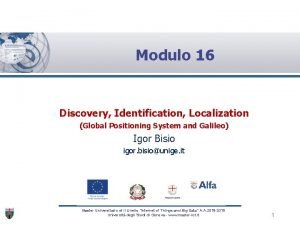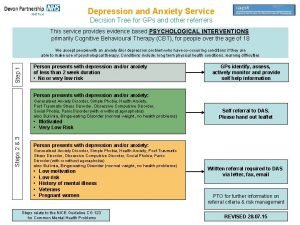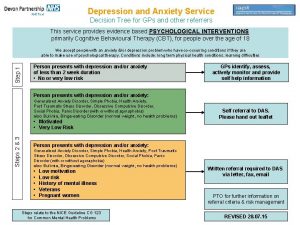Depression and Anxiety Service Decision Tree for GPs


- Slides: 2

Depression and Anxiety Service Decision Tree for GPs and other referrers This service provides evidence based PSYCHOLOGICAL INTERVENTIONS primarily Cognitive Behavioural Therapy (CBT), for people over the age of 18 Step 1 We accept people with an anxiety &/or depression problem who have co-occurring conditions if they are able to make use of psychological therapy. Conditions include: long term physical health conditions, learning difficulties Person presents with depression and/or anxiety of less than 2 week duration • No or very low risk GPs identify, assess, actively monitor and provide self help information Person presents with depression and/or anxiety: Generalised Anxiety Disorder, Simple Phobia, Health Anxiety, Post Traumatic Stress Disorder, Obsessive Compulsive Disorder, Social Phobia, Panic Disorder (with or without agoraphobia) also Bulimia, Binge-eating Disorder (normal weight, no health problems) Steps 2 & 3 • Motivated • Very Low Risk Self referral to DAS. Please hand out leaflet Person presents with depression and/or anxiety: Generalised Anxiety Disorder, Simple Phobia, Health Anxiety, Post Traumatic Stress Disorder, Obsessive Compulsive Disorder, Social Phobia, Panic Disorder (with or without agoraphobia) also Bulimia, Binge-eating Disorder (normal weight, no health problems) • • • Low motivation Low risk History of mental illness Veterans Pregnant women Steps relate to the NICE Guideline CG 123 for Common Mental Health Problems Written referral required to DAS via letter, fax, email PTO for further information on referral criteria & risk management REVISED 28. 07. 15

Depression and Anxiety Service Step 4 Decision Tree for GPs and other referrers Person presents with depression or anxiety with any of these features of risk or complexity: • Unclear presentation • Medium or greater current risk to self or others • Currently accessing other mental health services • Repeated treatment failure • Significant repeated and serious self harming • Multiple life problems having an impact on everyday functioning which reduces ability to engage in therapy Person presents with any of the following disorders, whether or not depression or anxiety are present: • Current psychotic features • Bi-polar disorder / Cyclothymia • Primary drug/alcohol problems • Anorexia, or other eating disorder where BMI is not in normal range. • Severe personality disorder NOT FOR DAS Please refer to DRSS or Crisis Resolution service as appropriate Risk assessment & management with DAS. The Depression & Anxiety Service is well equipped to provide psychological therapy for people with primary anxiety &/or depression in a primary care context. It is staffed by psychological therapists only. DAS can work with patients whose risk can be safely managed by psychological therapy and primary care interventions. Risk assessment and management requires clinical judgement. These descriptions & examples are intended to support communication & decision making Very low risk: Considered to have no history or warning signs indicative of risk. Low risk: Considered to have no current/ recent behaviour indicative of risk but history and/or warning signs indicate the possible presence of risk. No special risk prevention measures or plan required. (E. G. may have thoughts of harm to self or others but no intent or plans. May have self harmed in past. Not currently in adverse environment, no other risk factors) Medium risk: Considered to have significant risk. The history and current condition indicate the presence of risk to self or others which is a significant issue at present and a risk management plan is required as part of the persons care. (E. G. may have thoughts of harm to self or others and there is evidence of plans &/or intent. May have self harmed in past. In an adverse environment such as domestic abuse relationship or other risk factors) NEW EDITION 23. 06. 14



